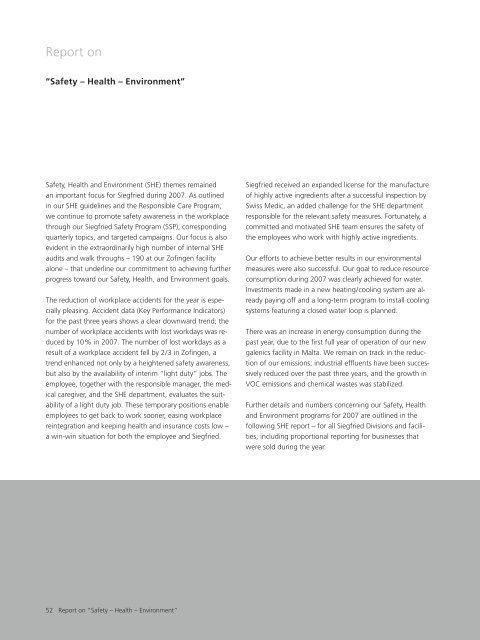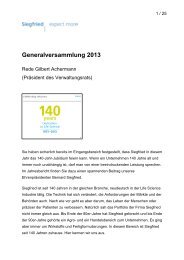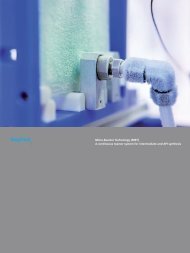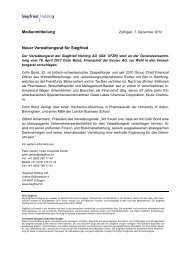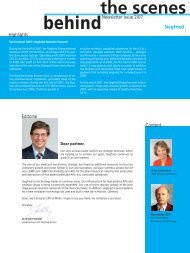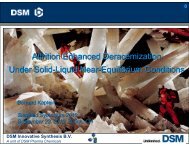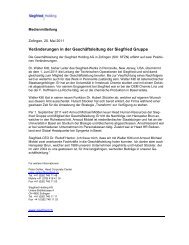Create successful ePaper yourself
Turn your PDF publications into a flip-book with our unique Google optimized e-Paper software.
Overview 2003 – 2007 1Key corporate figuresResourcesNumber of employees12001000800600400200Total energy c<strong>on</strong>sumpti<strong>on</strong> (1,000 giga joules)400300200100020072006200520042003020072006200520042003Number of SHE audits Zofingen (ZO) and Pennsville (PV) facilities250200150100500200720062005200420031If not specified, data valid for all of <strong>Siegfried</strong>54 <str<strong>on</strong>g>Report</str<strong>on</strong>g> <strong>on</strong> “Safety – Health – Envir<strong>on</strong>ment”
Emissi<strong>on</strong>s 1Industrial effluent / Zofingen & Pennsville (1,000 m 3 )800Chemical wastes w/o effluent sludge (1,000 t<strong>on</strong>s)256004002002015105020072006200520042003020072006200520042003CO2 emissi<strong>on</strong>s (1,000 m 3 )2015105VOC emissi<strong>on</strong>s (t<strong>on</strong>s)120100806040200200720062005200420030200720062005200420031If not specified, data valid for all of <strong>Siegfried</strong><str<strong>on</strong>g>Report</str<strong>on</strong>g> <strong>on</strong> “Safety – Health – Envir<strong>on</strong>ment”55
Resource c<strong>on</strong>sumpti<strong>on</strong>2003 – 2007 overviewUnit 2007 2006 2005 2004 2003Total energy GJ 376 000 373 000 379 000 344 000 360 000Natural gas GJ 192 000 202 700 186 500 191 000 198 000Heating oil GJ 22 500 21 200 13 000 11 000 18 000Alternate fuels (solvents) TAR GJ 29 000 14 000 57 000 27 000 22 000Electricity GJ 126 000 129 000 119 000 110 000 117 000Water m 3 1 600 000 1 940 000 1 761 000 1,437 100 1 887 100CommentsInvestments in new energy systems and modern producti<strong>on</strong>systems and c<strong>on</strong>trol systems stabilize energy c<strong>on</strong>sumpti<strong>on</strong>.For the first time, a full 12 m<strong>on</strong>ths of activity for the newpharmaceutical facility in Malta was added to our resourcebalance sheet, with a proporti<strong>on</strong>al increase in energy c<strong>on</strong>sumpti<strong>on</strong>.Fortunately, the growth trend in electric powerc<strong>on</strong>sumpti<strong>on</strong> was stabilized – despite increased use of airc<strong>on</strong>diti<strong>on</strong>ing. Electric power c<strong>on</strong>sumpti<strong>on</strong> in Pennsvilledripped by 5% thanks to lower utilizati<strong>on</strong> levels.Fossil fuels saw a shift from natural gas to alternativefuels (solvent-based). The increased use of such alternativefuels to power the thermal emissi<strong>on</strong> c<strong>on</strong>trol (TAR) systemsand to provide steam for producti<strong>on</strong> processes enabled afurther reducti<strong>on</strong> in the external disposal of waste solvents.The increase in the use of heating oil is the result of runningenergy intensive processes (such as high temperature reacti<strong>on</strong>s)in producti<strong>on</strong>.Zofingen, today already over 50% of the wastewater canbe released into the envir<strong>on</strong>ment as clean cooling water. The“water savings” goal for Zofingen was met.Goals 2008Zofingen and Pennsville– Updating the heating/cooling system– Stabilize energy use (cooling, air-c<strong>on</strong>diti<strong>on</strong>ing)– Optimize savings potential of:– Installing energy-saving bulbs and moti<strong>on</strong> detectors– Saving water in Zofingen– Saving nitrogen in PennsvilleThanks to updated heating / cooling systems and optimizedcooling water circulati<strong>on</strong> loops, overall water c<strong>on</strong>sumpti<strong>on</strong>was reduced across the company by just 18%. The systematicseparati<strong>on</strong> of sewage and cooling water led to a clearreducti<strong>on</strong> in the amounts of wastewater to be treated. In56 <str<strong>on</strong>g>Report</str<strong>on</strong>g> <strong>on</strong> “Safety – Health – Envir<strong>on</strong>ment”
Emissi<strong>on</strong>s2003 – 2007 overviewUnit 2007 2006 2005 2004 2003Chemical wastes w/o effluent sludge T<strong>on</strong>s 11 700 16 800 13 500 10 900 13 400Industrial effluent / Zofingen m 3 292 000 349 000 412 400 330 000 504 000Pennsville m 3 56 400 62 200 53 500 59 100 62 800CO2 emissi<strong>on</strong>s T<strong>on</strong>s 15 600 14 780 17 011 14 453 15 300VOC emissi<strong>on</strong>s T<strong>on</strong>s 48 62 57 51 104CommentsLarge amounts of c<strong>on</strong>taminated solvents result from theproducti<strong>on</strong> of pharmaceutical ingredients (due to producti<strong>on</strong>processes and regulatory guidelines). Recycling efforts are limitedby cGMP regulati<strong>on</strong>s, avoidance of cross c<strong>on</strong>taminati<strong>on</strong>,or product safety.Thanks to an “in-process recycling” method, over 2,000 t<strong>on</strong>sof solvents were recycled for use in the producti<strong>on</strong> process,eliminating the need to incinerate the solvents – and addinganother 6,000 t<strong>on</strong>s of CO2 to the envir<strong>on</strong>ment. The amount ofwaste solvents in both the Zofingen and Pennsville facilitieswas reduced by around 30%, due to lower utilizati<strong>on</strong> levelsand shifts in the product mix. Zofingen increasingly producedsmall batch products.Industrial effluent: the l<strong>on</strong>g-term goal to “save water”has also resulted in a decrease in the producti<strong>on</strong> of effluent, asthe amount of highly c<strong>on</strong>taminated industrial effluent wasclearly reduced. The multi-year program to reduce refractoryeffluent substances was rigorously maintained. The amount oforganic effluents in Zofingen was reduced from over 500 t<strong>on</strong>sto less than 430 t<strong>on</strong>s by implementing technical process measuresand targeted processing of critical effluent streams.VOC: Zofingen managed to maintain a low level of VOC emissi<strong>on</strong>swith the use of a thermal emissi<strong>on</strong> c<strong>on</strong>trol system (TAR)and a (low emissi<strong>on</strong>) solvent exchange. Pennsville is the sourceof 2/3 of the VOC emissi<strong>on</strong>s. Due to technical reas<strong>on</strong>s, availabilityof the exhaust air filtering system was limited. Fortunately,overall VOC emissi<strong>on</strong>s were reduced and our goal wasmet.Goals 2008Zofingen and Pennsville– Reducti<strong>on</strong> of persistent compounds in the effluent– Further optimizati<strong>on</strong> of recycling processes (solvents)– Reducti<strong>on</strong> of VOC emissi<strong>on</strong>s due to high availability ofthermal air cleaning system– Optimizati<strong>on</strong> of the waste water treatment in Pennsville(reducti<strong>on</strong> of amount of virgin acid) and suspendedparticlesThe effluent m<strong>on</strong>itoring program, “Single Material Analytics”was successfully c<strong>on</strong>tinued and now encompasses a library ofmany dozen intermediate and end products. These materialscan be analyzed in the effluent with modern analytic measures.This program helps <strong>Siegfried</strong> reduce polluti<strong>on</strong> by minimizingthe amount of undesirable pharmaceutical ingredientsin the water. The implementati<strong>on</strong> of this program – a keytask/goal – will be c<strong>on</strong>tinued.Carb<strong>on</strong> dioxide: Numerous factors led to an increase in CO2emissi<strong>on</strong>s. Zofingen burned more heating oil and solvents;which have a higher carb<strong>on</strong> c<strong>on</strong>tent than natural gas and producemore CO2 during incinerati<strong>on</strong>. The new facility in Maltawas operati<strong>on</strong>al for a full year for the first time.<str<strong>on</strong>g>Report</str<strong>on</strong>g> <strong>on</strong> “Safety – Health – Envir<strong>on</strong>ment”57
Goals 2008Zofingen and Pennsville– Less than 10 accidents with lost workdays per 1,000employees and less than 140 lost days due to accidentsper 1,000 employees.– Less than 35 accidents in total per 1,000 employees.– Quicker return to work through availability of lightduty jobs.– Implementati<strong>on</strong> of health awareness campaigns<str<strong>on</strong>g>Report</str<strong>on</strong>g> <strong>on</strong> “Safety – Health – Envir<strong>on</strong>ment” 59


